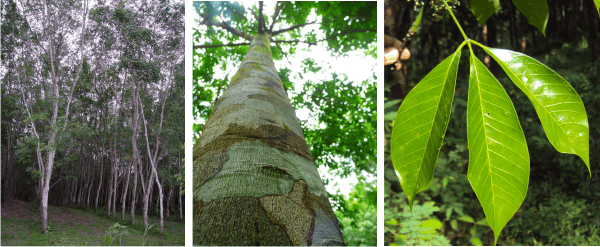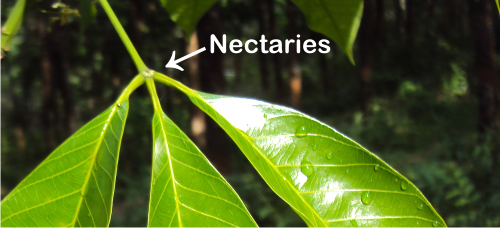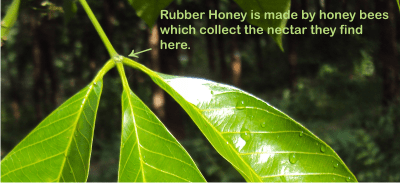Rubber honey is made from the rubber tree. Not from nectar found inside the flowers, or from honeydew as it happens with other trees, but from a nectar-secreting gland found outside the flower, on the young leaf petioles.
Scientific name: Hevea brasiliensis
Family: Euphorbiaceae, genus: Hevea
Other names: rubber tree, sharinga tree, para rubber, seringueira or rubber plant
Native to: tropical forests of the Amazon basin and Orinoco river valley in South America, it is grown in large plantations in Sri Lanka, Malaysia, Java, Sumatra, Thailand (which is the largest world exporter of natural rubber)
Main characteristics:
Ruber tree is a tree (not evergreen) that grows in tropical rainforests, often in areas that flood periodically growing to a height of up to 43 m (141 ft) in the wild, but much smaller when they are cultivated, because drawing off the latex restricts its growth.
The trunk is cylindrical and may have a swollen, bottle-shaped base. The bark is some shade of brown, and the inner bark oozes latex when damaged. The leaves have three leaflets and are spirally arranged.

How do rubber trees give us rubber? What is latex?
Rubber is made from the milky white liquid that runs through its vessels. It contains one third water and one third rubber particles, held in a form known as a colloidal suspension. Natural rubber is a polymer of isoprene (also known as 2-methylbuta-1,3-diene) with the chemical formula (C5H8)n.
To put it more simply, it’s made of many thousands of basic C5H8 units (the monomer of isoprene) loosely joined to make long, tangled chains. These chains of molecules can be pulled apart and untangled fairly easily, but they spring straight back together if you release them—and that’s what makes rubber elastic.
 Latex is collected during a process called rubber tapping. After the harvest latex is filtered, washed, and reacted with acid to make the particles of rubber coagulate (stick together). The rubber made this way is pressed into slabs or sheets and then dried, ready for the next stages of production: mastication (like chewing up), addition of some chemicals, squashing it into shape by rollers (a process called calendering) or squeezed through specially shaped holes to make hollow tubes (a process known as extrusion). Finally, the rubber is vulcanized (cooked): sulfur is added and the rubber is heated to about 140°C (280°F).
Latex is collected during a process called rubber tapping. After the harvest latex is filtered, washed, and reacted with acid to make the particles of rubber coagulate (stick together). The rubber made this way is pressed into slabs or sheets and then dried, ready for the next stages of production: mastication (like chewing up), addition of some chemicals, squashing it into shape by rollers (a process called calendering) or squeezed through specially shaped holes to make hollow tubes (a process known as extrusion). Finally, the rubber is vulcanized (cooked): sulfur is added and the rubber is heated to about 140°C (280°F).
Collecting the latex is much like collecting birch tree sap in Russia or maple syrup in Canada. It is called rubber tapping and implies slicing a groove into the bark of the tree at a depth of a quarter inch with a hooked knife and peeling back the bark. Trees must be approximately six years old and six inches in diameter in order to be tapped for latex.
The tree requires a tropical or subtropical climate with a minimum of about 1,200 mm per year of rainfall, and no frost. Its latex production declines as trees age (30+) and is usually cut down.
Flowers:
The inflorescence include separate male and female flowers. The flowers are pungent, creamy-yellow and have no petals. The fruit is a capsule that contains three large seeds; it opens explosively when ripe.
The compound leaves of the flowers bear extra-floral nectaries on the young leaf petioles. Nectar secretion is continuous while the leaves are young and cease when they mature – nectar is thus released only during flowering periods.
The flowering period includes January to March and the flowers last 7 to 9 days. The trees are visited by many types of bees: Apis mellifera (European honey bee), Apis cerana, Apis dorsata (the giant bee), Apis florea.
Weather conditions influenced the secretion of nectar from the extra floral nectaries. Rain washes away or diluted the nectar from the leaves resulting in severe economic loss to the beekeepers. The rainfall in 2008 honey flow season negatively affected honey yield.
Devanesan, S. et al. studied in 2011 the effect of weather on rubbur honey yield and concluded that the secretion of extra floral nectaries and in turn the production of honey from the rubber plant are related to the prevailing weather and climate change especially too much rains during the nectar secreting season will be harmful for honey production.

Pollen: the pollen grains are about 28 µm in length with 3 furrowed apertures with sculptured exine. Beekeepers say this pollen may be inadequate for brood rearing.
Rubber tree honey
It’s type of honey made from the nectar of rubber tree flowers. The particularity of this nectar is that it is not gathered from inside the flowers, but from special nectaries placed outside the flower, at the tip of the petiole, where the leaflets join.
The amount of nectar produced is highly variable and depends on factors including soil type, water supply, air temperature and humidity, hours of daylight, and time of day. In addition, nectar flow decreases as the flower ages (60 to 75 days).
Color: light amber
Taste: unique and pleasant with light aroma
Water content: 19 – 25% (high), average 22%
Crystallization: fast, in 2 months when kept at 28° – 30° C,and even faster when kept below 10° C
pH: 3.83
Total sugar content: 62.27%
Sucrose: 1.66%
According to Beekeeping, by S.N. Mahindru, in India rubber honey is different from regular floral honeys mainly in respect to moisture and enzyme content. The diastase value is low (mean 1.478), the invertase value is low (mean 1.630).
Here are some other characteristics of Indian rubber honey after Acidity 0.13%
Levulose: 37.14%
Dextrose: 35.98
Phenolic content: 385.63±24.86 mg GAE/100g
Flavonoid content: 63.40±3.78 mg QE/100g
Antioxidant value: low, 15.08±1.49 mg/mL (Ustadi et al.,2017).
In Malaysia the antioxidant power of 5 samples of honeys studied the antioxidant activity decreased as follows: sourwood > manuka > longan > gelam > rubber tree honey. (Mohammed Moniruzzaman et al, 2013)
FRAP value: 209.78 (μM Fe (II)/100 g)(while sourwood honey had 209.78)
Proline content: 184.75 (while manuka honey has 564.91)
Protein content: 2.14 (while manuka honey has 5.04)
Vitamin C: 132.68 mg/kg (high) (remember that Vitamin C concentrations decrease as the duration of storage increases!)
Considering Malaysian honeys, sourwood honey possesses the best antioxidant effects when compared with gelam, longan and rubber tree honeys as well as manuka honey.
Mineral content in Malaysian rubber honey (after Mohammed Moniruzzaman, 2014):
Ca: 141.17 mg/kg
Na: 83.17 mg/kg
K: 630.28 mg/kg
Mg: 59.07 mg/kg
Fe: 233 (very high) mg/kg
Zn: 56.13 (high) mg/kg
! Rubber honey is reach in Fe, while manuka honey is reach in Ca.
In all the samples analyzed in the study, the levels of the trace elements were within the permissible limit set by the FAO/WHO and there was no contamination of the honeys with pesticide residues.
! Rubber honey cannot be sold raw!
Due to its high content of water, rubber tree honey cannot be stored for long periods of time. It needs to be processed first (pasteurized) to ensure it will not ferment.
• In India, rubber tree honey is harvested using the European Apis mellifera, as most common species in the world and Apis cerana indica, an indigenous variety which is the most common species in the rubber plantations in Kerala and Tamil Nadu (India).
According to the Bureau of Indian Standards (BIS) specifications, honey (in general) is classified into 3 grades based on moisture content. Honey with 20% moisture is ‘special grade’, 20-22% is ‘grade A’ and 22-25% is ‘standard grade’. According to the specifications, rubber honey belongs to medium grade (Grade A) with an average moisture content of 22%.
In order to provide an alternate source of income, the Rubber Board is encouraging bee keeping among the rubber growers. They are offered training programs, financial assistance to farmers owning rubber plantations of 0.5 to 2.50 acre. It is a lucrative business as by installing 500 hives, a farmer can get up to 10 tonne of honey. The rubber plantations in India have the potential to produce 67.886 ton of rubber honey per year.
• In Malaysia, the stingless bee keeping, also known as meliponiculture is also encouraged in rubber growing areas, with the same purpose of enhancing rural livelihoods and combating poverty. Keeping stingless bees is much easier than working with regular hives of Apis Mellifera and honey production is lower, yet stingless bees colonies produce honey, pollen cerumen and propolis, which help a lot with health and daily life. For rubber smallholders, who depend on the fluctuating price of rubber, it is a good asset. (Shamsul Bahri, 2016)
read more about stingless bee honey
Where can we find rubber tree honey?
That’s a hard question if you are not from South Asia. Due to its high moisture content this type of honey needs to be processed (especially pasteurized) and there are not big producers to export this honey around the world. It does not have outstanding health qualities (like sourwood or manuka honey) to make worth the effort. Small rubber farmers produce it and it is mostly sold locally.
If you want to taste some, here is some Indian rubber honey found on FB: Vanamithra Honey. Amazon doesn’t sell it. Not even the Indian branch.
***********
*************
References:
https://www.explainthatstuff.com/rubber.html
https://en.wikipedia.org/wiki/Rubber_tapping
https://en.wikipedia.org/wiki/Hevea_brasiliensis
Rubber: a potential major honey plant in Thailand
Ustadi, Radiati, L.E., & Thohari. (2017). Komponen Bioaktif pada Madu Karet (Hevea brasiliensis) Madu Kaliandra (Calliandra callothyrsus) dan Madu Randu (Ceiba pentandra), Jurnal Ilmu dan Teknologi Hasil Ternak, 12 (2), 97-102.
Evaluation of physicochemical and antioxidant properties of sourwood and other Malaysian honeys: a comparison with manuka honey by Mohammed Moniruzzaman et al, 2013
Determination of Mineral, Trace Element, and Pesticide Levels in Honey Samples Originating from Different Regions of Malaysia Compared to Manuka Honey, by Mohammed Moniruzzaman et al., 2014
INFLUENCE OF CLIMATE CHANGE ON RUBBER HONEY PRODUCTION, by Devanesan, S., et al., 2011
Rubber tree picture source travel2unlimited.com
A rubber tree plantation in Phuket, Thailand picture source AxelBoldt via wikimedia commons
Hevea brasiliensis leaves picture source Vinayaraj via wikimedia commons

